Text
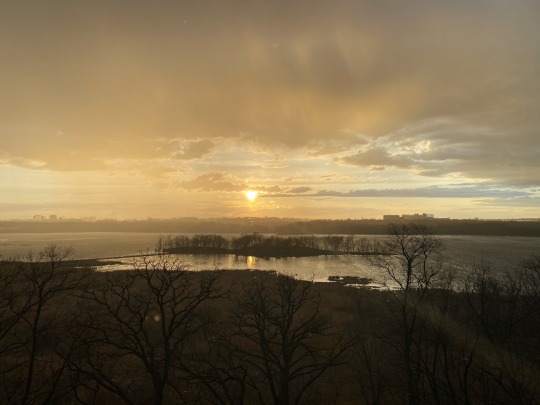
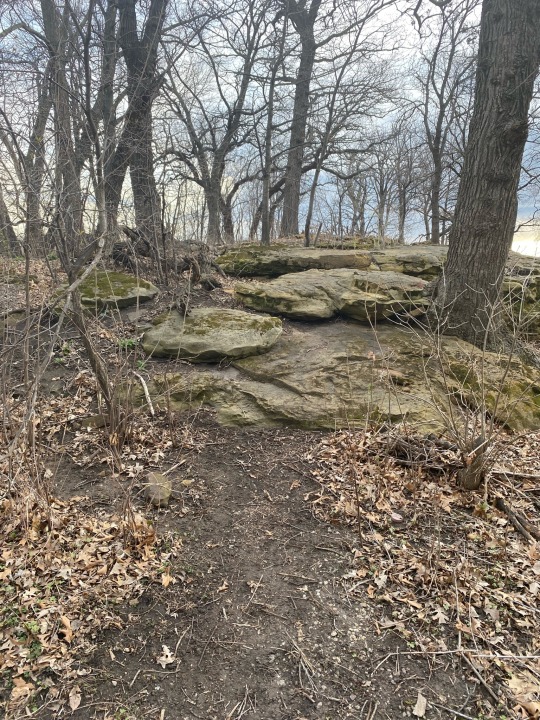

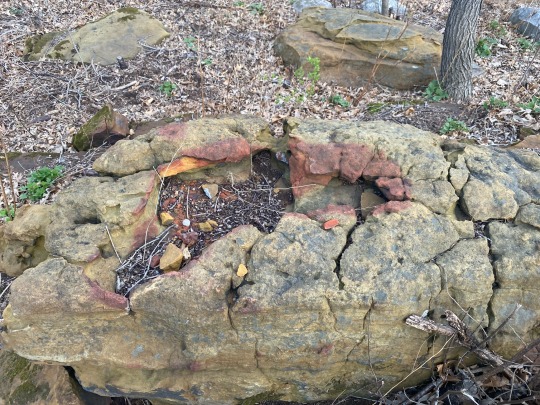
I’m trying to get back into the habit of evening walks/hikes, and after much deliberation this afternoon, I decided it was time to visit Quarry Island, which is off trail from Big Rivers Regional Trail. I was told it was a good place to find rocks — I’m on the hunt for some nice, round basalt. I found no rocks, since the waters were so high, but the island was gorgeous. You can see it from the overlook (first picture). I had to cross a railroad and wasn’t sure I was allowed out that way, but there was no one to stop me and I’m trying to build confidence anyway. The trail was on the map, so… off I went.
This area is known as Bdote to Dakota people, which is where the Minnesota and Mississippi rivers meet and lakes have sprung up. It is where many of the Dakota peoples originated, according to their stories. There are many beautiful plaques featuring Dakota (hi)stories and artwork. It was wonderful to read them and hear decolonizing insights about the advancements of the Dakota peoples and their stewardship of the lands before settlers arrived.

[ID: In the past, the Dakota people had no medical facilities or universities. Yet they survived and contributed to the world’s advancement through their own resources and systems of laws, customs, educational systems, and storytelling. The messaging features share Oceti Sakowin (Seven Council Fires) stories, creation stories commom to all Dakota people, and Hitunkakan Stories, traditional teaching stories that are specific to this landscape, so visitors may learn about Dakota worldviews and experience a gift of cultural knowledge. This project engaged Dakota elders, who are known first language Dakota speakers, and Dakota community members. Stories and lessons were selected with the intention to be appropriate for sharing with a larger audience. However, Dakota people have many versions of these stories, and they are all correct. Hecetu: this is so. This is Dakota Land. End ID]
The first and last couple sentences of this plaque really struck me, not out of surprise, but because it is rhetoric that would immediately shake up common white misconceptions about Indigenous lives and histories. Even as minor and obvious as these insights are, I do think shaking white settlers from complacency with such directness is invaluable. This blog is fervently supportive of Indigenous Land Back efforts, and I remain grateful for the educational work of Dakota peoples in spaces such as these.
As I strode off into the marshlands, redwing blackbirds and bank swallows were flying all around (see video! — ignore the tornado sirens, it’s Weather Awareness Day). Ducks nested in the reeds. Quarry Island itself is covered in mature swamp oaks, with evidence of a healthy mast year in the scattered acorn caps. The rocks made a perfect trail to the highest point in the island, where a large, almost altar-like rock sat (photos 2-4). The top was eroded from rainwater, and I left a snail shell I’d found further down in its hollow, wondering if the snail had made it that high in life. I offered clean drinking water, too. The rain I’d prepared to meet (I brought an umbrella!) was making its way across the lake at me, but I had some time before it arrived.
On the other side of the island was evidence others had been through. There were many buckthorn stumps and piles of branches. Some past visitor had neglected the first rule of rock flipping: put the rock back where you found it. So, I did my best to replace them. I found evidence of fires, too, and they were fairly fresh, based on the smell. At least they were on the rocks and not in the wooded areas.
By the time I made it back to the center of the island that the path bisected, the rain was coming in and the sun was beginning to set, signaling my time to return. I reached the overlook again just in time for sunset and took the first image. The rain was blowing upwards at me from below the bluff, hence the specs in the image. As I turned back towards my car, I saw this rainbow!
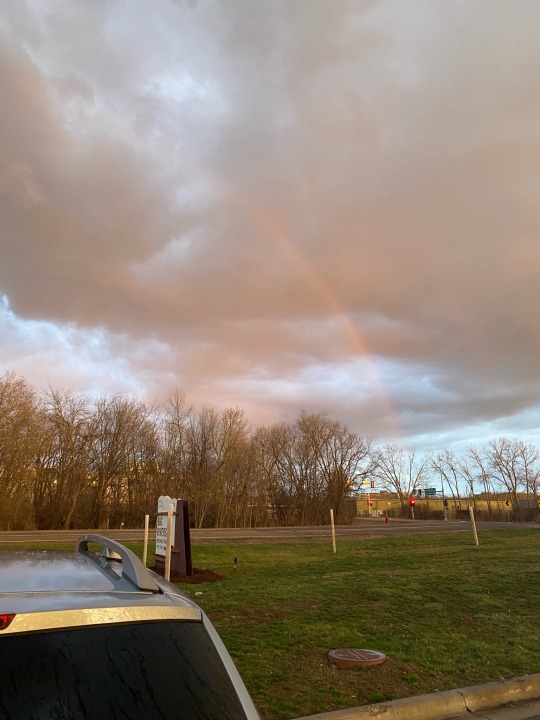
This was probably among my top five (if not top three) favorite hikes I’ve taken since I moved to MN. I will have to return to hike the rest of the trails north and south. I suggested the nearby firepits as a ritual site for my grove, too, so maybe we will all hike out to Quarry Island in the future.
8 notes
·
View notes
Text
otzi the iceman wouldn't treat me like this
673 notes
·
View notes
Text
It was cloudy here during the eclipse, so after our grove’s ritual, I spent some time beneath a rowan tree, listening to the frogs.
6 notes
·
View notes
Text




I’ve been dealing pretty severely with some grief following Nellie’s passing, as well as some burnout from work. So instead of wallowing in my guilt at home, I decided a walk would benefit my productivity. I’ve not visited Crosby Farms Regional Park since summer of last year (the last time I posted about it), and so I missed out on the change from summer to fall and to winter, but I don’t mind. Crosby and other parks along the Mississippi River bluffs south of the Twin Cities made me fall in love with the Season of Sleep. The beauty of winter, even without all the snow, is understated. Especially now in the early hints of spring, my love and respect for the subtleties of life in the winter only grows. Being able to see the underbrush and the sky through the canopy is a rare gift when it is hidden from human sight the majority of the rest of the year.
I most wanted to visit the local elderberry bush. With Beltane approaching and my considering entering the Second Order of the RDNA, I wanted to collect and prepare my sacrifices to The Morrigan now while the earth still sleeps so I wouldn’t disturb the bush as it grew. She is likewise beautiful in winter, and I’m almost certain I am not the only human who visits or cares for her, given her proximity to the path, the clearing she’s in, and the breadth of her canopy.
I brought my pruning sheers to only cut off sucker growth, as well as some fresh water to give in return, since there has been so little snow to protect the trees from drought. I was surprised to find, however, that she had several lose and broke branches tangled in and dangling from her canopy. So, as part of my offering, I disentangled those dead branches and tore down as much of the wild grape I could reach. There wasn’t much of the grape vines, so either she is resilient against it or, as mentioned, other people aid in her pruning, because few other fruit bearing trees aren’t absolutely overtaken by the vines in the park.
I ended up taking only one of the large downed and dead branches. It’s a little thinner than my thumb and maybe three feet long. I will be cutting it up into 9ths to feed to the Beltane fire throughout the evening, along with some offerings of rowan, my other guardian tree. I poured out my water bottle in thanks and snapped the other few pictures of the bush. I love the texture and color of the older growth (the deeply cracking bark) and how it compares to the younger growth (grey and bumpy). I also spied the tiniest of green buds to sprout into new branches this year, making me all the more glad there were downed branches I could take instead of cutting.
After walking the rest of the trail and taking a brief stride along the shores of the Mississippi, I headed home to settle into a little more work for the day.
1 note
·
View note
Text
As announced in February, political posts are now limited by default on Instagram and Threads. Accounts deemed “political” will have their posts suppressed from discovery. You can turn off this setting by going to ‘settings & privacy’ -> content preferences -> political content.
Instagram’s definition of political content is so broad it could mean anything:

3K notes
·
View notes
Text

Blessed Vernal Equinox to y’all. Fresh flowers for the altar, special incense to smoke-cleanse and bless the home, pineapple upside-down cake as an offering to the ancestors.
Also repotted my spider plants today. I usually wait until late summer/autumn, but they were lookin’ a little sad. I’m prone to giving them homes that are too big or too small. For the first few years of my spider pups’ independence from Spidey (RIP), I had four pups crowding one pot, which I was told was okay, but they didn’t seem to thrive. Finally split them all a couple years back (gave one back to Spidey’s original owner, which he promptly killed like Spidey) and now they are happy spiderlings. I am anxious for when they begin to throw pups, too.
#vernal equinox#druidry#druidism#offerings#altars#that’s a dyed domestic poultry feather (turkey? chicken? unsure but one of those)#(most likely goose based on shape)#it’s the best i got for the Morrigan considering the migratory bird act#that is a law i definitely prefer to follow
3 notes
·
View notes
Text
To Worship a War Goddess in the Modern Era
This devotional writing is dedicated to the Great Queens, Na Morrígna, She who has called me to service. Inspired by a nightmare, this writing is offered to uphold an exchange. May these words aid not in teaching others how to think, but in learning to listen.
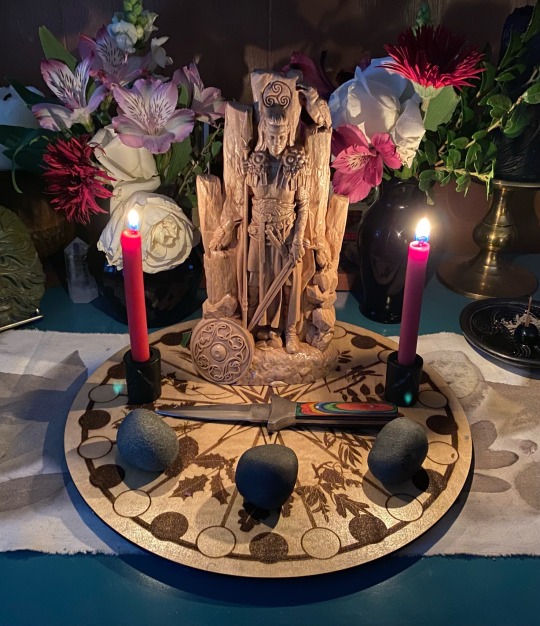
One thing since being called by the Morrigan that I’ve had difficulty resolving is the Morrigan’s being a war goddess in the age of the military industrial complex, where wars, especially on the part of the US and other imperialist nations, are fought not for sovereignty or “defense,” like so many USAmericans are raised to believe. Authors on the Morrigan agree war has changed since the days of her worship among the Celts, but none I’ve found talk about what it means to worship her in the face of wars fought for unjust causes and for profit, or the fact that veterans are made forgotten victims instead of honored warriors, or in watching the genocide of the Palestinian people, among other ongoing injustices worldwide. I worry that sovereignty for the Morrigan is equated with imperialism, colonialism, and white supremacy, especially given some personal history interacting with devotees who themselves hold such values. Surely, with just how sick the land and its people are thanks to poverty, climate change, etc., the current “sovereigns” in power do not have the Morrigan’s blessing?
I admit I do not have all the answers or all the vocabulary to speak as strongly as I feel on this topic. As only an Acolyte still forging my relationship with the Morrigan, I am in the process of learning what worship of a war goddess in the modern age looks like. The Morrigan and her care have changed since ancient times, and they should. Her being able to do so speaks to the power of what she represents and the needs of the communities who call on her. Her complexity only grows in the modern age, especially in the face of global economies and imperialism, and as her worship is taken beyond the bounds of her homelands. Thus, I am left wondering how to consider or work with her warlike aspects.
In folklore, the Morrigan is often an antagonist, appears to fight for the “wrong” side, and starts wars out of nowhere. Authors like Courtney Weber (2019) and Stephanie Woodfield (2021) mention that we do not know for what purpose she started wars in ancient times, but both urge that the concepts of war and violence are complex not just to the Morrigan but to humanity. The Morrigan, by her very nature and actions across even her seemingly mortal lifetimes, is a goddess in the grey areas who rejects false binaries between life and death or war and peace. She teaches us not to believe in things blindly or warns us against simple stances on complex subjects. Jewish Witch, devotee of the Morrigan, and staunch anti-Zionist Asa West (2014) says, “The Morrígan implores us not to glorify war or reject all armed conflict on principle, but rather to understand and work through humankind’s propensity towards violence.” I think to deny violence on principal, and especially to uncritically shame its use by others, is a shortsighted stance. I firmly believe in the necessity of violence to end violence. I believe that victims of state-sanctioned violence have a right to defend themselves. I believe that nonviolence has its place (this is the purpose of magick, after all, as well as the Morrigan’s and the Celts’ battle cries, so that enemies may be deterred from battle), but it cannot be the only way to peace when the tools and means to defend oneself are available and help ensure one’s right to life. In these ways, I feel that I understand the Morrigan better. She is not a goddess of war and violence to glorify it, but because it is a facet of our reality. If there are any gods to rule over war, I would want her to be one who understands all its facets, complexities, necessities, goals, and consequences, who mourns as well as celebrates, who seeks peace as its ultimate means, and knows that none of it is so simply defined or easily attained.
So how does the Morrigan fit into modern concepts of war, if we recognize violence as a both a reality and a necessity? To that end, I think it is important to look at the ways war has changed in modern times. To USAmericans and other global imperialist nations, wars are rarely if ever fought locally. Our views of war have become physically distanced as a result of deploying our people overseas, selling weapons to arm other peoples for us, and by employing technologies like drones for environmental terrorism. All this makes obliviousness to and normalization of war easier, contributing to willful ignorance to those impacted by the machinations of individuals who perpetuate and profit from it. As a result of the military industrial complex, I think the purposes of war get lost and even corrupted. I fear oversimplifying this discussion, but I find it important to at least describe how a world economy based on war not only distances us from the realities of war, but makes it easier to forget the different types of, ways that, and reasons for which wars have been and can be fought. Given how often the concept of sovereignty is debated in the Morrigan’s community, perhaps the concept of war requires it, too, because I refuse to believe in a god who would condone the actions of, incite the kinds of violence perpetrated by, or fight for a “side” like those of Israel and United States over the years.
In the modern age, I think the Morrigan incites the internal wars, too, both within the individual and within a country’s political climate through protests, demonstrations, political movements, and the like. These, too, are wars, where violence occurs and where it has shown to be necessary, though not the only armaments for change and peace. Wars for justice in the modern era are ones that have brought us concepts such as Restorative Justice, which seek not only to put an end to things like retributive justice and the concept of a carceral state, but improve the lives of even perpetrators of violence and harm. Woodfield (2021) says of the Morrigan that this is the true cost of peace:
“I could hear the Morrigan in my mind, saying, ‘The true price of invoking peace is that you bless even your enemies, so that all might be whole again.’ Because how you end a battle is sometimes far more important than how you began it in the first place. Or how you fought it […] [A]ll people will remember is how it ended. […] Peace really isn’t peaceful. It’s earned only when you are willing to fight for it.” (p. 67)
Peace doesn’t mean people aren’t held accountable—that’s among the ideas that Restorative Justice seeks to uphold. Peace means ensuring all involved parties learn, grow, and heal from the experience.
And it is why that I believe the Morrigan revels in these grey areas of the definitions of and purposes for war. All authors agree the Morrigan is a peace-bringer as much as she is a war-maker. Those who analyze her mythologies will tell you she wages the wars she does specifically to bring about the kind peace she ushers at the end of the Battles of Moytura. Perhaps the true reasons of the wars mentioned in the mythologies are lost to time or have been romanticized for the purposes of a good story, but there are still lessons to be learned there, I think, for the Morrigan’s faithful.
I am personally drawn to the myth of Macha Mong Ruad, who, in defeating Dithorba’s sons, did not kill them, but charged them with constructing her fort, Emain Macha. Rather than killing those men, she reintegrated them into society, she gave them work, and she presumably treated them well so that they could complete that work. I see that work being a form of justice as they took part in the construction of safety and peace against which they had originally rallied out of selfishness and disrespect for Macha’s sovereignty and gender identity. I imagine they most definitely were outcasts among Macha’s people henceforth. Her people even question why she spared the men in the first place. Shame is a necessary for accountability to take place, and it is sadly something perpetrators of violence and injustice avoid or refuse to let themselves feel, because oppressors can only ever imagine the violence they commit being done unto them. Macha’s decision was an important one for her to make so that not only was peace maintained and her power demonstrated, but also so Dithorba’s sons could be given time to learn the lessons of their transgressions and experience all facets of accountability, including shame.
Peace is a war, too, as we try to heal and restore others to health and happiness, give even our enemies the space not just to learn from and internalize the lessons we have sought to teach them through war, but now ensure that they thrive because of it. Revenge on and eradication of our enemies is what we have been taught war is in the modern era, but I prefer to entertain the notion that that is not what it should be. I would love to reach an era where international wars are fought differently, where machines of violence are eradicated, and where the struggle is spent learning to empathize, learning to negotiate, and learning to wish wellness upon even the people who have hurt us. Revenge and retaliation distract us from and become easy ways out of the harder, healthier work. Thus, we must work to get there, which in this day and age means making use of the tools available to us in order to secure not only our survival and victories, but our abilities to thrive afterwards.
I like to think the Morrigan knows all this, too, and this is what she wants. If she didn’t before, then maybe she knows now as her worshippers have found her across all corners of the globe and as she has grown and changed with them. I think it is important to remember that faith and spirituality are ecologies: there are things gods can do that mortals cannot, and there are things mortals can do that gods cannot, so they rely on one another. I think that ecology includes the negotiations for change and growth, if we are all living and continually changing aspects of nature. Change is good, change is expected. It is a war goddess like the Morrigan, whose changes are near constant, I would trust with the domain of war. May we all, in the face of war both just and unjust, learn to grow, change, and heal together just as fervently as we fight.
#the morrigan#free palestine#druidism#devotional writing#lots of writing this week#trying to get it done ahead of the dark moon this weekend so i can make good on a request i feel the morrigan is making of me#thid has been in the drafts since January and since my February mew moon ritial i have been receiving#clear signs that I should finish what i started#so here we are
24 notes
·
View notes
Text
When the Morrigan Calls an Atheist
Originally published in The Connexus of Reformed Druidry, Midwinter 2023. Sharing to my personal blog for the purposes of reaching a wider audience.

I consider myself an atheist druid. I do not believe in the existence of any gods, and I have a strong aversion to organized religion in the face of cultural Christianity and the US’s modern political climate regarding the separation of church and state, or lack thereof. I won’t lie about my still holding those aversions, including to those who consider themselves Christian druids–identities that seem at odds, given Christianity’s historic colonialism and its methodical destruction of indigenous cultures worldwide. But I have Reformed Druidry to thank for my efforts at pluralistic acceptance. I thank, too, my involvement in the LGBTQ+ community. A quote within the Bisexual Manifesto from Anything That Moves: Beyond the Myths of Bisexuality (1990) sticks with me: “There are as many definitions of bisexuality as there are bisexuals.” For the bisexual community, this frame of mind is an important one in the face of historical, systemic, and even internalized biphobia, where one is continually told to “prove” their bi-ness, that having preferences means they aren’t “actually” bi, or that marrying someone who isn’t the same gender as you means it’s a “straight-passing” relationship. Using this understanding, I am able to move much more quickly past questioning one’s labels and into acceptance of and trust for the ways one understands themselves. If a druid can be a Christian, then maybe an atheist can devote themselves to a god…
And so what does an atheist druid do when the Morrigan calls? What does the call of The Morrigan sound like to someone who wants absolutely nothing to do with gods, nor to be associated with theolatry, even if the gods invoked in the RDNA can be interpreted as aspects of nature or Jungian archetypes in the collective unconscious of humanity? Can the gods call to an atheist in the first place? These are questions I ask even myself after having been initiated as an Acolyte of the Order of the Morrigan this past October.
I knew very firmly when I began my druidic studies in May of 2022 that I would be approaching my practice as an atheist. I sought plainly to learn about druidry, celebrate the High Days, and enjoy nature in ways that I used to growing up. Studying druidry, like some study Buddhist philosophy, was a way for me to integrate my desire for intellectual growth, my care for my health, and my political activism. Intertwining all three helps me to live my life holistically and intentionally. My druidic practice consists of learning about plants, animals, and various religions and their gods not as a way to collect knowledge, but to understand the worldviews and lessons that cultures both living and dead have to teach. As a result, I deepen my empathy for others and for myself. I find studying divination to be especially enjoyable, and I even find it useful as an atheist. I think that suspending disbelief is a healthy practice, if not a pleasant diversion. I also see it as an aid to a busy mind. Divination can be helpful in not only listening to one’s intuition, but finding focus where there is chaos. When I am feeling emotionally distraught or when I am struggling to make a choice, I love doing Ogham readings. Whether picking a singular stave or placing a full spread, my divinations help me surrender decision fatigue and cold logic in favor of the imagination, creativity, and serendipity.

Thus, I believe the Morrigan first began “calling” me when my Elder Ogham stave fell off my altar in October 2022. Without noticing, it snapped beneath my boot in my rush out the door. I struggled to attach meaning to what had happened – a fun exercise I set upon myself. Elder is associated with protection, healing, cycles of death and rebirth, and even sacrifice. Had my Elder stave “protected” me from something? Had I or would I sleight someone, causing the “death” of a relationship? What else might be dying and be reborn, or even interrupted in that process, as symbolized by the break? Was there a sacrifice I was being asked to make? I did not know, and no answer came. I replaced the stave in my collection and burned the broken, unfixable stave as part of my sacrifice later that Samhain. Things were quiet in the months ahead, but then over and over again, the names and their various spellings associated with the Morrigan would appear before me in reading, in passing, in meeting people. And in my nature walks, I kept spying plants that I would later discover to be associated the Morrigan, often in unexpected places or forms I did not immediately recognize until using an identification app. Chiefly among those was Elder, both red and black varieties native to the US, as well as hawthorns and nightshades.
All the while, and since beginning my druidic studies in May 2022, I was dealing very strongly with some grief. I’d hit the point where existing in my grief was beginning to weigh on me and frustrate me. I did not know how to move on. I did not know how to stop wallowing or what actions to take to make a difference. I was ready to enter that big “acceptance” stage that everyone talked about, but which I’d only experienced fleetingly or only logically but not emotionally. Studying druidry was one of the ways I hoped to find some method of managing my grief and finding joy again. It was working, but the grief still held me quite tightly moving into 2023.
When I finally caught the pattern of the Morrigan’s names and plants appearing in my life, I began my research. What could those appearances mean? Why was my brain picking up on those patterns? What tied them together?
In the three dark moons since dawning my devotional pendant, I am, naturally, still seeking the answers to those questions. I find these exercises of logic and imagination more entertaining than anything serious to pursue, but I can at least describe what I’ve gotten out of the experience thus far. A simple start to an answer might be that I relate to the ideas, the images, the lore, and the messages of the Morrigan. She is a peacemaker as much as She is a warmaker. Through Her many incarnations, She has survived and overcome adversity and grief of all kinds. She knows what it means to be more than how others perceive you. I can appreciate what She has come to mean for women, queer individuals, and survivors of all kinds in the modern era, and it is that mutability of Her image between the past and in the present that also draws me to Her. Transformation and change, including to those of the current times, seems right up Her alley. Hers are qualities I would like to see in myself.

When Elder appeared to me on my walks for the third time earlier this year, that’s when I decided I would do something out of character for how I viewed myself as an atheist druid – I would join The Order of the Morrigan. I was already familiar with the liturgy John the Verbose had composed a few years prior, and with that third, final sign, I felt that it was the push towards the threshold of change I was looking for in my grief. I would use my initiation as a right of passage beyond my grief, to work to make change, to fight to pull myself out of where I had been wallowing so I could move on. As serendipity would have it, the day of October’s new moon was also the day of the partial annular eclipse for Minnesota, and John the Verbose was kind enough to allow the ritual he planned to simply be my initiation that day. All around, it felt not only appropriate but auspicious to have my initiation take place during a time of introspection and new beginnings. I went into it not just hoping it would be the hallmark of change in my life, but with the intention of making it the moment of change.
I’d spent the month prior making my preparations. I strung my devotional pendant, I wove my sling from hemp, I collected three black sling stones from the orange agate-speckled shores of the Mississippi near my apartment, and collected the Waters of Death there, too. I procured some of my second-favorite elderberry wine that John would consecrate as the Waters of Life. And I fashioned the first iteration (of three – I’m bad at sewing) of my vestments if the Morrigan accepted me. I awoke the morning of the ritual to the calls of the crow family that had moved into the forest across the street, and it was taken to be a sign.
The day was a little chilly and overcast, occluding our views of the eclipse for a majority of the time, but it meant more to me that the grove officers were all there, standing in solidarity with me. But as serious as the mood of the ritual is meant to be, it is difficult not to laugh as you crush a tomato in your fist with your grovemates in the splash zone…
When John asked for a sign of the Morrigan’s acceptance, he made an acorn divination while the calls of bluejays (my favorite corvid) rang out in the distance, heralding new beginnings, commitments, and the responsibilities therein.
And I did, indeed, feel a renewed sense of purpose, per the liturgy’s closing admonitions. I can say with certainty that while I still have good and bad days with my grief, I feel resolute in efforts to curate a more hopeful future for myself in spite of my grief.
My first few months as an Acolyte have been devoted to my research of the Morrigan. As an Acolyte, I am seeking to deepen my relationship with Her and what She represents. I have learned a lot. Studying what She means to peoples of the past and present has allowed me to learn about myself, too. “Shadow work” or self-reflexivity seems to be an important part of devotion to The Morrigan. It is something that comes naturally to me, which doesn’t mean it’s easy, but it’s affirming to know that something I work hard to practice is also something well-practiced by the Morrigan’s devotees.
And to be sure, I am still an atheist. However, I would be remiss not to treat my studies and engagement with the Morrigan’s lore and community with the same level of respect and seriousness that Her believers do. As an Acolyte of the Morrigan, I see myself as a student to Her teachings, rather than a worshiper. And if I were to become a Priest to Her Order someday, I might be more likely to consider myself a representative of Her interests and values.
I’m certain that as I continue my studies and deepen my relationship with The Morrigan that I may come to new realizations, and they are something I welcome. I am in a continual state of learning and becoming. I think atheists get a bad rep for being killjoy skeptics, but I see myself as just being deeply rooted in reality, working to keep an open mind for things that cannot or have yet to be explained, and trying to have more than a little fun while I’m at it.
Peace to the heavens!
7 notes
·
View notes
Text
Reposting here from my main blog. This is a death positive space. Had to say goodbye to my nearly 19 y/o cat today. Currently figuring out if I wanna do anything druidic for her, too.
I wanna talk about it, but I know not everyone’s as keen to hear about it. Part of my grief also contains this great joy and excitement for how it went and what a gift the experience was, is, has been. I’ll put it under a read more, just in case, and it’s already tagged appropriately. Let me know if anyone needs additional tags.
There’s now a dead cat in my freezer. Weirdest thing I’ve ever done and may ever do. I’m going to have Nellie’s pelt tanned and bones cleaned (no carion beetles, because of the phenobarbital ☹️), and to prepare for that I have to freeze her ahead of shipping her off to the taxidermist.
And I’m so thankful I’ve gotten to do that in the comfort of my own home. My friend (technically an ex, if we use the widest definition of the word) came over. He used to hate cats before he met Nellie 6 years ago. I taught her to high five specifically because he would tease her by waving his fingers in front of her face when she wanted scritches. He cried the whole time, and I’m glad at least one of us was. I cried the weeks leading up to this, and I’m definitely crying now, but I didn’t cry at all through the procedure. Maybe I’m too afraid to cry in front of people these days, and/or I was psychologically protecting myself, but I also think it was important for me to remain calm and cognizant so I could experience Nellie’s passing fully and without fear. This is what I’d wanted for her, and what I would want for myself.
I’ll be honest when I say I felt relief yesterday when Nellie’s blood tests came back looking as bad as they did. It meant the burden of deciding when to let her go was decided for me. There was nothing else to be done besides hospitalization and expensive, invasive treatments that would do nothing to return her to her usual self. My policy since her diagnosis three years ago was to ensure her comfort and happiness, rather than keep her alive for my sake. I didn’t know when that would be, and I dreaded waiting too long or choosing too soon. The last thing I wanted was a middle-of-the-night emergency with no one to call to for help, or to let her go when she still had fight left in her. Thankfully, and in spite of her definitely having reached a point of serious illness, discomfort, and lethargy, the decision could at least be easy and ensure she remained comfortable.
In the last 24 hours, I ensure she got her midmorning sunbaths. She ate more for me than she had in the past three weeks. And she spent most of the night in bed under the covers with me, which she’d never done in her whole life despite how badly I wish she would have. She was always her own cat, but these last few days and hours let me care for her in beautiful, fulfilling, and healing ways, the memories of which I will forever cherish.
I can’t recommend at-home euthanasia enough. The vet and student arrived and thankfully just went right to it. I appreciated their firmness, which I’m sure they did to ensure it got done AND to set boundaries for their own mental health. I like boundaries like that so I can structure my own actions appropriately. I didn’t feel rushed at all, and the vet even asked if I was ready. I think I needed to happen swiftly, too, so that I wouldn’t second-guess myself.
When it was time, I held her curled in my lap on the couch. The doctor had me hold her face away in case the opiate injection startled her, but she was calm. The vet and assistant left the room, saying it could take up to ten minutes to fall asleep, but she was out within a minute or two, which is normal for cats as ill as she was. Her heart was racing as it took effect and she was swallowing a lot since the opiates can make them nauseous, but then she just slowly relaxed with her head and paws curled up in my hand. My friend and I just pet her and talked and laughed. I value the chance to have some lightheartedness in there, which I would not have gotten if I’d been alone. Death can be a serious matter, but I think it should be joyful, too. It was a time to celebrate Nellie, which meant telling jokes about her nonsense.
After another 8 or so minutes, the vet and assistant returned. Cats as old and dehydrated as she was are hard to stick, so it took a couple tried to find a vein for the phenobarbital, but once the vet did, it was swift. He said before the plunger would hit the bottom she would likely be gone, and she was. I felt her heart slow and still very quickly, and I felt her body go a little more slack than only sleeping. The vet took a long moment to listen and confirm her heart had stopped before confirming what I already knew.
He would step out again for a few minutes and return to confirm a second time she had passed, just to ensure everything worked as intended. In that time is when she took that final, reflexive gasp as her nervous system fought to keep her alive. I was dreading that, worried I’d think she was suffering, but I wasn’t freaked out at all. It was a nice, slightly reassuring confirmation that she was, indeed, gone. She died with her eyes open, if they didn’t just open naturally after her passing. It is very like her to want to stare death in the face of greet whomever/whatever waited for her, and then to give me difficulty in trying to get them closed.
For the next hour and a half I held and pet her body. I told stories about her and talked about death and my plans for her body. My friend and I talked a lot about growing up, as well as about our opposing feelings about death, where I am very frank and silly about it, and he is more fearful. I am thankful for his presence and acceptance of me and my weirdness, and especially his love of my cat. I can’t imagine this have going any better.
I wish I could make Nellie understand. I wish I could get her opinion. I wish I could know 100% across all time and reality and in spite of whatever afterlives do and don’t exist that this was the right decision. But I’m glad I made it so that she could be comfy, so that I could hold her while she fell asleep, so that I could feel her pulse stop and hear her last breath. It was peaceful and beautiful and heartbreaking, and I don’t know what I’m gonna do without her meowing as the soundtrack to my day.
Blue Jean napped at my side the whole timw. I woke her up so she could sniff Nellie’s body at least one last time and to ensure she knew her friend had passed. She gave Nellie two little licks on her cheek. It seemed like Blue Jean had mostly been avoiding Nellie for the past couple weeks, never grooming her like she normally would. I am hopeful she knows and accepts this loss, and I hope if she mourns that we can manage it together.
My friends and I are going to play some TTRPG tonight so I can still have a little bit of normalcy today. I fear being alone at the moment, just because I don’t know what to do with myself without my routine revolving around this cat, so I am grateful to at least have more company tonight. I worry I am trying to repress, but I think this writing gives me the chance to actively process this experience and present emotions. Grief is nonlinear, I know, so I’m sure there will be sobbing and guilt and fear and depression later, but right now I am sad and happy and grateful and comforted and exasperated with my weirdness and tired.
Rest in peace, my dearest kitty cat. Thank you for nineteen years of whatever the fuck we had. I hope your next adventure is fulfilling and that you remember our time together with fondness.
3 notes
·
View notes
Text
IMPORTANT: TUMBLR HAS MADE A DEAL WITH MIDJOURNEY/OPENAI.
YOUR ART AND IMAGES ON TUMBLR ARE BEING USED TO TRAIN AI MODELS.
The opt-in is automatic, but you can turn it off in settings.
Go to "Blog Settings" -> "Visibility" -> "Third-Party Sharing" and turn it off. (Visual example here.) You need to do this with every sideblog.
Spread the word. Everyone on Tumblr needs to know about this.
5K notes
·
View notes
Text
Oh and if literal grass-touching IS viable, I also advocate for touching invasive grass. Many parks in the US have invasive plant removal volunteer work days. You get some air and some exercise and you can talk to other volunteers if you want or you can just march off into the trees on your own and start wreaking havoc with various hand tools. If you want to do something that is both useful AND destructive, I have found nothing better
27K notes
·
View notes
Text
“I loathe that word ‘pristine.’ There have been no pristine systems on this planet for thousands of years,” says Kawika Winter, an Indigenous biocultural ecologist at the University of Hawaiʻi at Mānoa. “Humans and nature can co-exist, and both can thrive.”
For example, in the Proceedings of the National Academy of Sciences (PNAS) in April, a team of researchers from over a dozen institutions reported that humans have been reshaping at least three-quarters of the planet’s land for as long as 12,000 years. In fact, they found, many landscapes with high biodiversity considered to be “wild” today are more strongly linked to past human land use than to contemporary practices that emphasize leaving land untouched. This insight contradicts the idea that humans can only have a neutral or negative effect on the landscape.
Anthropologists and other scholars have critiqued the idea of pristine wilderness for over half a century. Today new findings are driving a second wave of research into how humans have shaped the planet, propelled by increasingly powerful scientific techniques, as well as the compounding crises of climate change and biodiversity loss. The conclusions have added to ongoing debates in the conservation world—though not without controversy. In particular, many discussions hinge on whether Indigenous and preindustrial approaches to the natural world could contribute to a more sustainable future, if applied more widely.
3K notes
·
View notes
Text
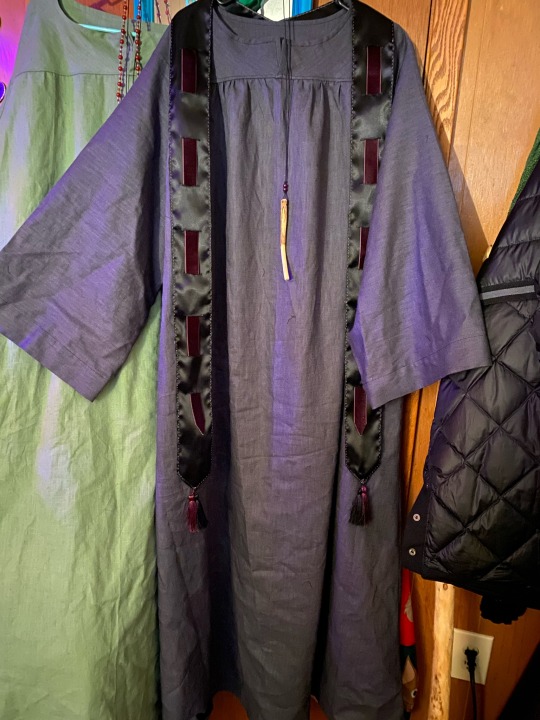
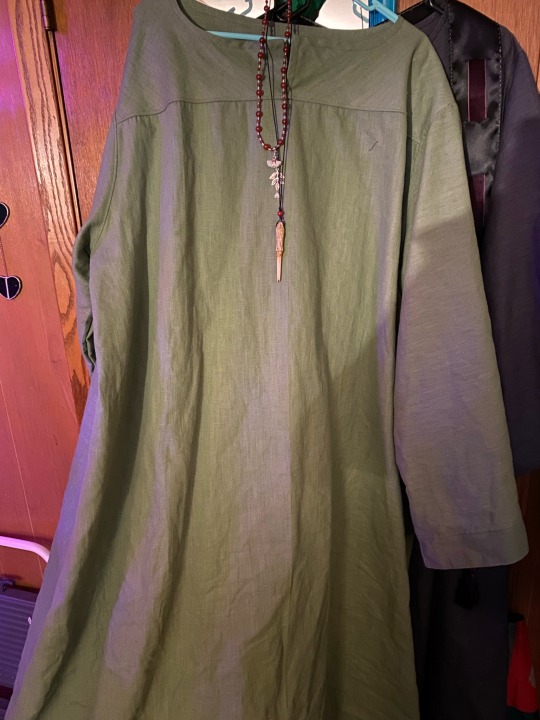
I’m having an extremely difficult time deciding what to wear to the public Imbolc ritual my grove’s been invited to conduct at the Carleton College Chapel, which is the campus where Reformed Druidry began in 1963.
On one hand, I could be there as a representative of the Order of the Morrigan, wear my black/purple ribbons, and elder wood jewelry.
But on the other hand, I could wear green with my rowan jewelry and more closely represent the ties to Brigid that our ceremony seeks to celebrate. I worry I would be disrespecting my personal guide/guardian who chooses to present itself in the form of rowan if I showed up in my vestments Morrigan on this particular high day.
I could always mix the two options. The red beads looks as good on the dark grey robes as much as the purple of my ribbons, but it feels more put-together if I just wear the elder. I’m going to be waffling until the last moment, most likely. 😖
3 notes
·
View notes
Text

Made a Macha-themed leather bracelet! I don’t know if I’m 100% happy with it yet, and I may end up deconstructing it (again) to try a new setup, but I’m definitely much happier with this try. I wanted to use purple so that I could have a version of my ribbons wherever I go. Courtney Weber’s The Morrigan: Celtic Goddess of Magic and Might provided the inspiration. Her book includes a number of suggestions for making items with magical purposes, and this was one for times of strife that she recommends one wears while reciting a small prayer whenever reassurance is needed.
Celtic horse charm from SpringMoonFarm!
1 note
·
View note
Text
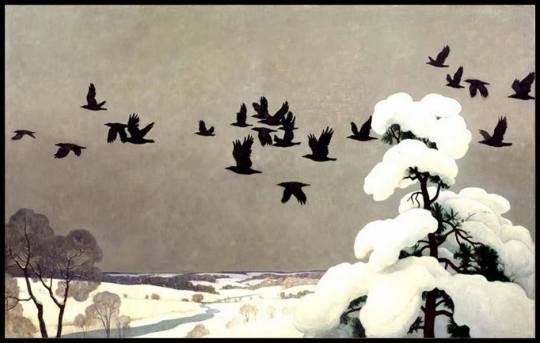
N. C. Wyeth (1882-1945)
Crows in Winter (1940-1941)
pencil on paper 37.7 x 59.3 cm
Brandywine River Museum
4K notes
·
View notes



